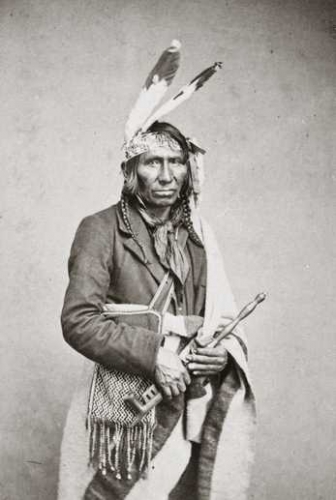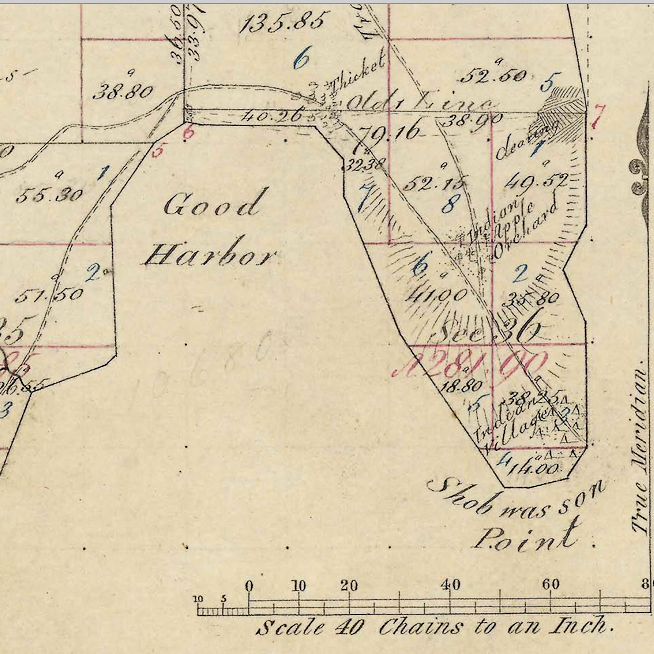The Plot Thickens

Iaweshowewekesik (Crossing the Sky), 1863. Iaweshowewekesik was a leader of the Gull and Rabbit Lake Ojibwe.
A few weeks ago fellow researcher Eliot Singer decided to collect and transcribe many relevant documents relating to the Grand Traverse region prior to the Civil War. Amongst the treasures he found is a recently digitized slew of documents from the Commissioner of Indian Affairs. Eliot has put forth a Hurculean effort with these transcriptions, bringing together many previously separate threads of stories, and the result is that we have a new perspective on a number of things, hence the title “The Plot Thickens”.
Most of you know that my major interest recently has been uncovering the history of Grove Hill School, and there is much here from Eliot to expand and enrich that story line. There are references to official policies regarding instruction of Indian students in their native language which deserve to be investigated. Eliot also believes that there may be a connection between the publication of the 1856 Ojibwe Bible and the subsequent falling out between Dougherty and Peter Greensky, an observation which deserves more analysis.
So here is the opening salvo of observations from Eliot, which may serve as an introduction and guide to his Mission Period, Grand Traverse, Epistolary documents. Comments will be left open on this post, in the hope that we may generate a few ideas and discussions.
Mark Smith
cover photo: Iaweshowewekesik (Crossing the Sky), 1863. Iaweshowewekesik was a leader of the Gull and Rabbit Lake Ojibwe.
••••••••••••••••••••••••••••••
Some observations by Eliot Singer
A few months ago, I discovered the National Archive had finally digitalized many of the Commissioner of Indian Affairs microfilms of Agencies most relevant to Ojibwe (Chippewa) and Odaawaa. In the past, I have used the physical microfilms at the MSU library and found it too difficult to do more than copy short excerpts, except for a few items essential to my research. Now, with the luxury of sitting at my computer, enlarging, etc., I was able to browse, try to decipher, and transcribe. Around the same time, the Presbyterian Archive letters from Reverend Peter Dougherty became easily available.
The result is that I became addicted to seeing how a number of story lines, some of which I was previously unaware, played out. So, I ended up transcribing and compiling extensively, mostly letters, hence the title Mission Period, Grand Traverse, Epistolary. My hope is people will first read it as a whole, like you would an epistolary novel, noticing all the intrigue, intertwining narratives, and character complexities.
But of course, this is also a resource for further research and analysis. I have incorporated some of this material to cover the Mission period for an update to my analytical Oral and Witten Histories of Odaawaa and Chippewa Settlement of Northwest Michigan. There is also much that has me wondering, and I am sure there is more others will notice that I’ve missed. Just a few examples:
1) The published 1836 Treaty contains only the version amended by the Senate. Having access to the original, plus the “assent,” signed at Mackinac a few months later, is illuminating in many ways. I was intrigued to see one “Chieftainess” among the assent signatories. There are also some things that don’t make sense. I have doubts that the Oshawun Epenaysee who signed the treaty in Washington was really the minor chief, Shawun Epenaysee, probably within Akosa’s band, of Grand Traverse, rather than the major chief of Grand Island, otherwise missing. I believe the handwriting for the signatures is that of Augustin Hamlin, who would have known those from L’Arbre Croche well, but not necessarily others. This also raises the question of who gave the names (for this and other treaties). There was great reluctance to state personal names: “If a name has to be given, say to be put to some document, and the man is asked his name, he will not give it; but, after a long period of hesitation and embarrassment, he will indicate some other man who will tell his name” (Rev. Joseph Gilfillan, “The Ojibways of Minnesota,” Collections of the Historical Society of Minnesota, ix, 1901, pp. 111-112). If Hamlin (or Schoolcraft or Hulbert), only knew names second or third hand, mistakes would have been easy to make. There is also a very difficult to decipher signature for Grand Traverse, on the assent, beneath Aish Kwaygwonabee—“Nanens Ugomo [?]”—with Akosa missing. I wonder if this was alterative name for him, perhaps Ininiins Ogimaa (current orthography), Little-man Chief—he was referred to as “the young chief.”
2) Mark Smith and I have been trying to figure out more about Nagonabe, who was Chief of the Cat Head band when Reverend Smith visited in 1848 and became associated with Wakazooville. But there was no Cat Head band in 1839, and the only person with that name on that annuity list was a member of the Manistee band, of which Kewaygooscum was chief. Nagonabe had signed the 1836 assent, identified as from Grand Traverse. Reverend Smith noted for May 7, 1851: “Went to Nagonabes to see about the difficulty between him and Kewaguiskum—he said he did not know that Kewaquiskum struck him—perhaps he said he fell into the fire, he said he had no hard feelings toward him—he was not badly hurt…report says he is going to kill Kewaquiskum then he & his Band flee to Canada but he denies any evil intention.” In 1854 Nagonabe’s departure for Canada was one of the death blows to Wakazooville. Kewaquiskum must also have gone to Canada, because Smith’s entry for October 21, 1857, reads: “entered the selection of Kewaquiscum Chief of Manistee Band & 2 or 3 of his people they have lately returned from Canada.” So, this is where historians sometimes need to speculate (speculations are not facts!). My speculation is that Nagonabe was the leader of a splinter faction of the Manistee Band and there was bad blood between him and the chief. Splits within bands, leading to the formation of new bands, were commonplace.
3) Enjoy the spat between the Johnstons and Dougherty (and his Presbyterian allies). Spoiler alert! William later sends his daughter (paying tuition) to Grove Hill. In the late 1850s, William, in need of a job, goes after his buddy Augustin Hamlin and his white wife, who did not speak “Indian,” was hired as a teacher.
4) Dougherty (virulently antagonistic to Papists) was moved from Old to New Mission in the Eagle, which I believe must be the schooner belonging to ardent Catholic, Peshabe. Despite chiefs and many others of Grand Traverse bands having signed a petition complaining of how, with their money, priests and ministers had bought land in their own names, apparently the first annuity funded purchase at New Mission (not just of mission property) was registered as by Walter Lowrie.
5) In 1856, a translation into Ojibwe of the entire New Testament was published. One impact seems to have been that Dougherty lost control of the message.
6) A. J. Blackbird took to using that as his official name. Folks at Grand Traverse knew him as Jackson Makaté-binési (modern orthography). He seems to have been the instigator behind petitions in the aftermath of the 1855 treaty seeking changes to education and was in need of a job.



